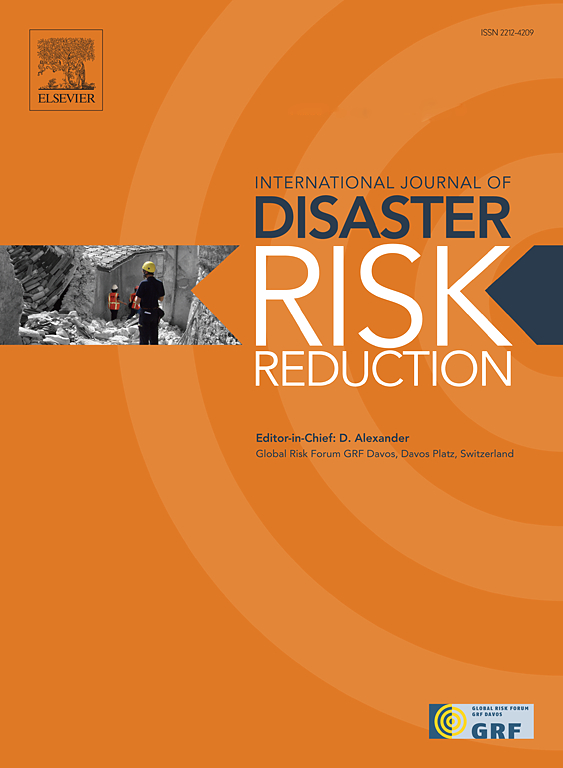Anatomy of a historic blackout: Decoding spatiotemporal dynamics of power outages and disparities during Hurricane Beryl
IF 4.2
1区 地球科学
Q1 GEOSCIENCES, MULTIDISCIPLINARY
International journal of disaster risk reduction
Pub Date : 2025-05-15
DOI:10.1016/j.ijdrr.2025.105574
引用次数: 0
Abstract
Power outages are a significant consequence of natural hazards, severely disrupting communities' restoration and recovery processes. Despite the increasing frequency and impact of hazard-induced power outages, empirical studies examining their spatial and temporal characteristics across impacted regions remain limited. This dearth of empirical insights inhibits the ability to quantify impacts and examine vulnerability and equity issues for effective resilience investments. This study investigates the spatial patterns and temporal variations in outage duration, intensity, and restoration/recovery following the 2024 Hurricane Beryl in Houston, Texas. This historic blackout caused widespread power disruptions across the Houston metropolitan area, leaving more than 2 million customers without power over several days, resulting in more than 143 million total customer-out hours. By examining the dynamic interplay between outage impact, recovery features, and socioeconomic and infrastructural factors, the analysis identified key determinants contributing to disparities in power outage impacts and recovery efficiency delineated by ZIP Code across Houston. The findings reveal that areas with higher population density and proximity to the hurricane's path experienced more severe initial impacts. Regions with higher median income showed faster recovery, while lower-income areas exhibited prolonged restoration periods, even with favorable infrastructural conditions, suggesting disparities in restoration speed. The study also highlights how urban development features, such as road density and land elevation, explain spatial disparities in power outage impacts and recovery. This research advances the understanding of power outage dynamics in large metropolitan regions through four key contributions: (1) empirical characterization of outages from a historic hurricane, highlighting infrastructure vulnerabilities in a high-density urban context; (2) comprehensive analysis using multiple metrics to capture spatiotemporal dynamics of outages and restoration; (3) leveraging of high-resolution outage data at fine geographic scales and frequent intervals to quantify and reveal previously masked spatial disparities; and (4) systematic examination of socioeconomic, urban development, and environmental factors in shaping disparities in outage impacts and recovery timelines. These findings provide infrastructure managers, operators, utilities, and decision-makers with crucial empirical insights to quantify power outage impacts, justify resilience investments, and address vulnerability and equity issues in the power infrastructure during hazard events.
历史性停电剖析:解码贝里尔飓风期间停电和差异的时空动态
停电是自然灾害的重要后果,严重扰乱了社区的恢复和恢复进程。尽管灾害导致的停电频率和影响越来越高,但在受影响地区对其时空特征的实证研究仍然有限。这种经验见解的缺乏抑制了量化影响、检查脆弱性和公平问题的能力,从而无法进行有效的弹性投资。本研究调查了2024年飓风Beryl在德克萨斯州休斯敦造成的停电持续时间、强度和恢复/恢复的空间格局和时间变化。这次历史性的停电造成了整个休斯顿大都市区的大范围电力中断,导致200多万客户在几天内没有电,导致总客户停电时间超过1.43亿小时。通过检查停电影响、恢复特征以及社会经济和基础设施因素之间的动态相互作用,分析确定了导致停电影响和恢复效率差异的关键决定因素。研究结果表明,人口密度较高和靠近飓风路径的地区最初受到的影响更严重。中等收入较高的地区恢复速度较快,而中等收入较低的地区即使基础设施条件较好,恢复时间也较长,表明恢复速度存在差异。该研究还强调了城市发展特征,如道路密度和土地高程,如何解释停电影响和恢复的空间差异。本研究通过以下四个关键贡献促进了对大城市停电动态的理解:(1)对历史性飓风造成的停电进行了实证表征,突出了高密度城市背景下基础设施的脆弱性;(2)利用多指标进行综合分析,捕捉停电与恢复的时空动态;(3)利用精细地理尺度和频繁间隔的高分辨率停电数据,量化和揭示以前被掩盖的空间差异;(4)对造成停电影响和恢复时间差异的社会经济、城市发展和环境因素进行系统检查。这些发现为基础设施管理者、运营商、公用事业公司和决策者提供了重要的经验见解,以量化停电影响,证明弹性投资的合理性,并解决灾害事件期间电力基础设施的脆弱性和公平性问题。
本文章由计算机程序翻译,如有差异,请以英文原文为准。
求助全文
约1分钟内获得全文
求助全文
来源期刊

International journal of disaster risk reduction
GEOSCIENCES, MULTIDISCIPLINARYMETEOROLOGY-METEOROLOGY & ATMOSPHERIC SCIENCES
CiteScore
8.70
自引率
18.00%
发文量
688
审稿时长
79 days
期刊介绍:
The International Journal of Disaster Risk Reduction (IJDRR) is the journal for researchers, policymakers and practitioners across diverse disciplines: earth sciences and their implications; environmental sciences; engineering; urban studies; geography; and the social sciences. IJDRR publishes fundamental and applied research, critical reviews, policy papers and case studies with a particular focus on multi-disciplinary research that aims to reduce the impact of natural, technological, social and intentional disasters. IJDRR stimulates exchange of ideas and knowledge transfer on disaster research, mitigation, adaptation, prevention and risk reduction at all geographical scales: local, national and international.
Key topics:-
-multifaceted disaster and cascading disasters
-the development of disaster risk reduction strategies and techniques
-discussion and development of effective warning and educational systems for risk management at all levels
-disasters associated with climate change
-vulnerability analysis and vulnerability trends
-emerging risks
-resilience against disasters.
The journal particularly encourages papers that approach risk from a multi-disciplinary perspective.
 求助内容:
求助内容: 应助结果提醒方式:
应助结果提醒方式:


